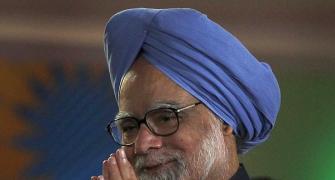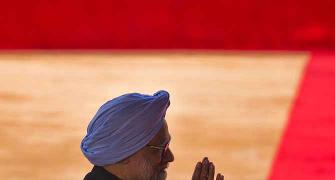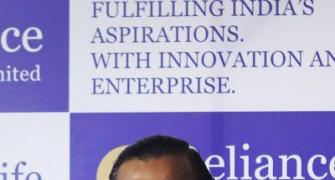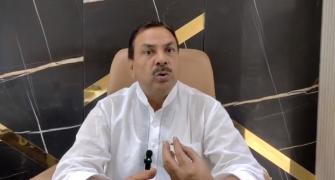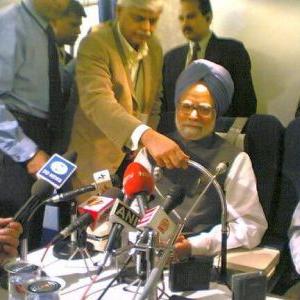'The UPA's claim of growth at 9.5 percent was absolute nonsense and a fraudulent claim because the country did not grow; it was only statistical growth.'
'I do believe that when there is a determined leader who wants to bring a desired change, the system will begin acting. Today, people think there is policy paralysis, but there is functional paralysis also.'
'When things start moving, people will invest. Many companies are holding cash, many people are not investing. Nobody is making any move. Everybody is waiting for the elections to get over.'
Economist and Swadeshi Jagran Manch convenor Swaminathan Gurumurthy in conversation with Shobha Warrier/Rediff.com
Swaminathan Gurumurthy, the convenor of the Swadeshi Jagran Manch, never minces words while airing his opinion on the Indian economy.
This hour-long exclusive interview with Shobha Warrier/Rediff.com is no different.
Here is Gurumurthy on what ails the Indian economy and how it can be revived. Also on Narendra Modi, the leader and the Gujarat model of development.
The first of a two-part interview:
The Indian economy, currently growing at 4.5 percent, is said to be at a low phase. Do you think the UP (United Progressive Alliance) messed up the Indian economy?
The UPA not only messed up the economy into a low growth rate, even when the economy was at a high growth rate of 9.5 percent in the first 4, 5 years of its rule, you will be stunned to know that the total employment growth was only 2.7 million. This happened between 2005 and 2009.
On the contrary, in the five years of the NDA (National Democratic Alliance) rule, the employment growth was over 60 million, that is, 12 million a year.
So, what is the use of posting growth without employment growth? Even the so-called growth rate conceals a huge unemployment. What does it show? Just financial capitalism. Unfortunately, this is not widely known.
Is this due to, like many allege, the government selling land with natural resources to show growth?
This is what is known as asset inflation. There is a huge debate going on in the world about how just by inflating the asset values, you show higher incomes and higher Gross Domestic Product. Many studies have come out on this.
In India, the asset inflation in terms of real estate, gold and stocks has been due to foreign money flowing into India. This created a huge statistical growth and not real growth.
When there was huge liquidity at the global level, money was flowing to wherever there was some return. The Indian stock market was booming partly because the stock market was booming and partly because of the money flowing in. When foreign exchange reserves were booming, you didn't know what to do with the money. Foreign exchange reserves means the government acquires it by paying with the Indian rupee.
When an exporter converts the rupee into the dollar, he reduces his bank liabilities on which he must have paid 12%, 13% interest. But when the government acquires the foreign exchange reserves, it gets only 1.4% in the international market. So what happens is, the government is saddled with foreign exchange which has no returns.
So the UPA government felt the best way is to freely allow capital goods import so that anyone who wants to invest should be given license to import capital goods.
The average capital goods import till 2004 was about $10 billion a year. In 2005, it was $25 billion which went up to $37 billion, $49 billion, $67 billion and went up to $99 billion in 2011-2012.
The total capital goods import was $587 billion which completely destroyed the local capital goods manufacturing.
Is that why manufacturing has registered negative growth in India?
Yes. Capital goods manufacturing fell down by 11% and the general manufacturing which was about 11% in the first five years of the UPA rule came down to 5% in the next four years and then it fluctuated between positive and negative.
The government made 0 rated import duty to facilitate imports, and the total tax concessions that were given averaged 5.5 lakh crores a year for six years!
Who benefitted from this; those who came with foreign money?
Two people benefitted. The exporters there and the importers of capital goods here.
When the power sector, the steel sector, etc began importing goods, it did not add to the manufacturing of India. In fact, it dented the foreign exchange to the extent of $587 billion which is more than the net oil import of $515 billion.
People say it is the oil imports and gold imports that dented India. No, it is the capital goods imports. That is only because the government was getting money in the stock market.
It soon became a chaotic economics and nobody had any control. At some point, somebody should have stopped it.
And the tax cuts they gave -- an average of 2.5 lakh crore every year! In February 2005, Dr Manmohan Singh and P Chidambaram made statements that our tax rates were very low and that they were going to withdraw all exemptions. It was a shocker! This was disclosed in the Budget document but nobody reads it.
You know how much companies that earn more than Rs 500 crores pay as tax? 23.5 percent. It is companies that earn less than a crore pay 27 to 28 percent, and that is because their capacity to claim exemption is limited.
The difference between the levied tax of 33 percent and the difference between the effective tax worked out to Rs 2.5 lakh crore in the first five years of the UPA rule, and in the next five years, it doubled.
That was because in 2008, they have this stimulus and brought down excise duty from 16 to 8 percent, and in some cases, 0 percent duty was allowed in power sector for projects above 1000 MW. This means it was a tsunami in India.
On one hand, you are losing foreign exchange and on the other, you are losing revenue. Rs 30 lakh crore was the tax give away in five years. This resulted in the fiscal deficit of Rs 23 lakh crore.
So the government finances were hit, foreign exchange was hit, local manufacturing was hit and there was no addition to employment; just 6 crore employment in the first five years and 27 lakh employment in the next five years. So the economy was completely smashed.
The UPA's claim of growth at 9.5 percent was absolute nonsense and a fraudulent claim because the country did not grow; it was only statistical growth.
We have an economist as the prime minister, but unemployment is the biggest problem India faces now...
Unfortunately, Manmohan Singh's economics is based on the American experience. He knows very little about India. I wouldn't fault him. It is the Indian media and the Indian intellectuals who celebrated him as an economist.
There is no economist for the whole world. It has to be specific to the society; what that particular society with its skill levels and resources and competence, can produce is what matters. In that, I don't think Harvard experts can do anything.
Manmohan Singh may not even know that there are 43.2 million non-farming enterprises which employ 100 million people for which the bank finances are only 5 percent. It is this sector that requires bank advances. Banks should finance them through the non-banking finance sector as they only reach these people.
In Karoor, you may have a bank official who may not even know the local language. It is the economics of disconnect. There is a disconnect between economic thinkers and economic players; there is a disconnect between the government and society, and also the media and the society. The media that is dealing with the economics of India is completely Anglo-Saxon which cannot understand India.
I think we require more focussed, geographically-relevant economic policies.
Look at employment. Even during the liberalisation period, the private sector employment went up from 7.4 million in 1991 to 11.4 million in 2011. It means just 4 million employment addition in the entire liberalisation period.
The public sector employment came down to 3 million in this period. Rise in private sector, decline in public sector and it is only the small scale sector, the medium scale sector, micro enterprises, the Micro, Small and Medium Enterprises sector that has sustained the employment of India.
You spoke of geographically-relevant economic policies. The other day, Narendra Modi spoke of the need to change Centre-state relations as most of the funds for projects come from the Centre. Should it be more federal with more powers to the states?
Changes are required at three levels. I don't think we need more federalism. We need more federalism in the intellectual approach to India. We have an Anglo-Saxon approach to all and that is where we are wrong.
The Constitution is okay, even the systems are okay, but we think everybody should be moving in one particular way and that is the Western way.
If you look at how businesses progressed in Gujarat and Punjab, it is not because of just government policies but because of the alignment between the government and society. There are entrepreneurial communities everywhere.
Once you understand the social forces at work, you can work on how to replicate that in other areas. The government must appeal to communities to take to businesses, but they are making them to take to politics. The drive of India is social capital and families of India.
In the Western model economics, there is no word called family or community. Today, they are slowly recognising the need for social capital which is the capacity of the people to function together. That was what has produced Tirupur, Namakkal, Karoor, Ludhiana, Rajkot and Jamnagar.
Look at the GDP. 14 percent of India's GDP comes from the corporate sector. The government contributes 22 percent. Agriculture is about 17 percent. And the rest of the 40 odd percentage comes from the non-corporate sector. But there is no policy focus on that.
Many economists say the Indian economy is in such a low phase that it may take another 2, 3 years for the economy to show signs of growth. Do you agree?
I do believe that when there is a determined leader who wants to bring a desired change, the system will begin acting. Today, people think there is policy paralysis, but there is functional paralysis also.
The coal secretary had said, the prime minister's orders were over-ruled by junior ministers. How did this happen? That shows the system was chaotic.
You mean, it was lack of leadership that put the economy in such a pathetic situation?
It was not lack of leadership; there was no leadership. The known leader was not the leader, and there were people acting behind the scene. And people acting behind the screen had no accountability whether it was Sonia Gandhi or Ahmed Patel.
If what Dr Singh's former advisor Sanjay Baru says is believed today, it is because that was the impression everyone had earlier too. If he had said this in the case of Atal Bihari Vajpayee, people would have said, he was lying.
So I have a feeling it was not policy issue alone, but functional paralysis that affected the Indian economy so badly.
How hard will it be for the next government and next prime minister to set things right on the economic front?
This can be changed by one person having the political and constitutional authority. He can say, these three things can be done in the next six months. One change is the actual change, and the other change is the perception.
When things start moving, people will invest. Many companies are holding cash, many people are not investing. Nobody is making any move. Everybody is waiting for the elections to get over, for the last one year.
For all of them, if there is a clear direction, things will start moving.
Image: S Gurumurthy. Photograph: Sreeram Selvaraj
Part II of this fascinating interview: 'Modi is a clean, determined man, ambitious of his place in history'
For a different point of view, please read Growth in the time of UPA: Myths and Reality
- Complete coverage: Election 2014

